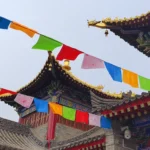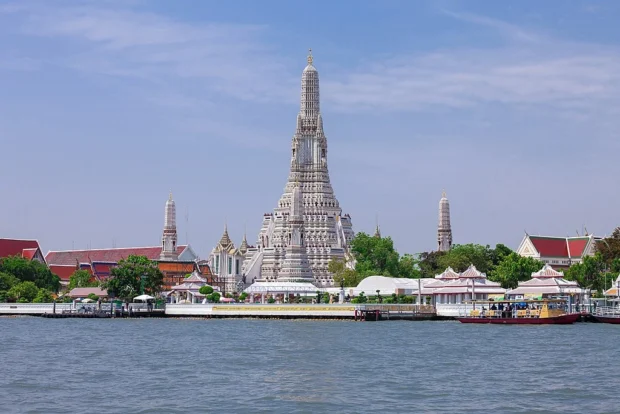Bangkok, Thailand’s bustling capital, is home to countless historic and spiritual treasures, and one of the most striking among them is Wat Arun, the Temple of Dawn. Nestled on the west bank of the Chao Phraya River, this temple stands as a symbol of elegance and craftsmanship, drawing travelers eager to absorb its peaceful aura and stunning architecture. Visitors often look for directions, best visiting times, and insights into its rich past before stepping through its gates. This guide brings you the essential knowledge about Wat Arun to enrich your visit, along with useful tips on nearby places to stay, tasty local treats, and how to reach this iconic landmark from central Bangkok.
Table of Contents
Getting to Wat Arun from Bangkok’s City Center and Airport
Arriving at Wat Arun is part of the experience, involving scenic river views and local transport methods that add charm to the visit. From central Bangkok, the easiest way is to take a river boat on the Chao Phraya River. Pier Saphan Taksin serves as the main departure point for these boats. Visitors can board the cross-river ferry at the Tha Tien pier on the east bank to reach Wat Arun on the west side.
For those arriving at Suvarnabhumi Airport, taking the Airport Rail Link to Phaya Thai BTS station followed by the BTS Skytrain to Saphan Taksin is a smooth option. Then, hop on the river boat to complete the journey.
This route itself offers glimpses of daily life along the riverbanks and a window into Bangkok’s harmony between urban energy and tranquil waterside views.
Architectural Splendor and Spiritual Importance of Wat Arun
Wat Arun’s design is a masterpiece of Thai craftsmanship, dominated by its central prang, or Khmer-style tower, which rises majestically over 70 meters high. This tower is decorated with colorful porcelain and seashells, meticulously placed to catch the morning sunlight, creating a magical glow that has inspired awe for centuries.
The temple’s construction dates back to the Ayutthaya period but took its current form during the reign of King Rama II in the early 19th century. It became particularly significant when King Rama II chose it as the royal temple, symbolizing the rise of a new era. The name “Temple of Dawn” reflects local belief that the dawn brings fresh hope and spiritual renewal, a theme echoed by the temple’s eastward orientation.
Wat Arun remains an active place of worship and ceremony, hosting important religious events such as the Royal Barge Procession, when ornately decorated boats glide along the river, paying homage to the temple.
After visiting Wat Arun, you might appreciate the calm charm of Chiang Mai’s old city, where peaceful temples and quiet streets offer a gentle pace.
The Unique Craftsmanship and Decorative Details
One of Wat Arun’s most enchanting features is its intricate decoration using hundreds of thousands of tiny pieces of Chinese porcelain and ceramic tiles. These were originally ballast from trading ships, repurposed into dazzling mosaics. Walking around the temple’s terraces, visitors see guardian figures, floral patterns, and mythological motifs that tell stories from Buddhist and Thai folklore.
Climbing the steep stairways to the higher terraces offers close encounters with these details and panoramic views of the river and surrounding cityscape. Despite the climb, the calm atmosphere and craftsmanship make the effort worthwhile.
Optimal Times to Visit for Peace and Beauty
Visiting Wat Arun in the early morning, just after the temple opens, rewards guests with soft light reflecting off the porcelain facades and fewer crowds. This quiet time allows for reflection and photography without rush.
Late afternoons before sunset are also magical, as the fading light casts a warm glow, and the temple’s silhouette contrasts beautifully against colorful skies. Weekdays tend to be less crowded than weekends, offering a more serene experience.
Keep in mind that the temple closes around sunset. Arriving well before closing time ensures you have enough time for a thoughtful visit.
If you want to feel the heart of Bangkok beyond Wat Arun, the page about Visit Bangkok shows many more temples, markets, and calm spots around the city.
Practical Visitor Tips and Reservations
Entry to Wat Arun requires a small admission fee, which helps maintain this cultural treasure. Visitors should dress respectfully: shoulders and knees covered, and shoes removed before entering the temple buildings. Photography inside some areas is restricted, so observe posted signs and honor local customs.
For those who appreciate Thai temples, exploring Wat Phra Kaew’s royal artistry and spiritual history makes a natural next step.
For those interested in guided tours, many local guides offer insightful walks that explain the temple’s symbolism and history. Booking in advance through reputable tour companies or at the temple’s visitor center is recommended during peak seasons.
Nearby Accommodation and Culinary Delights
While luxury hotels are found across Bangkok, travelers seeking proximity to Wat Arun often opt for charming guesthouses or boutique hotels located along the riverside on either bank. These accommodations offer stunning views of the temple illuminated at night and easy access by boat.
Food lovers will not be disappointed. Near Wat Arun and within walking distance on the east side, street vendors and small eateries serve traditional Thai dishes. Sampling freshly made pad thai, grilled river prawns, or mango sticky rice amidst ambient riverside settings makes the visit even more memorable.
For a calming respite from the city’s buzz, some visitors enjoy traditional Thai tea or herbal infusions served in tea houses nearby, where the aroma and warmth offer moments of reflection.
Local Legends and Surprising Stories
Beyond its visual appeal, Wat Arun carries fascinating myths. One tells of the giant demons that once protected the temple, guarding it against dark spirits. Another story recounts how the temple’s porcelain decorations were gifts from Chinese traders, symbolizing the bond between the two cultures.
Curiously, the temple’s central prang resembles a lotus bud, a symbol of purity and enlightenment. This shape reinforces the spiritual message of awakening carried throughout the temple’s design.
Official Information and Further Planning
For the most accurate and current information, including opening hours and any temporary closures, the temple’s official site provides valuable resources. Please feel free to check its website to plan ahead and check details for tours and events.
By taking the time to delve into the cultural, architectural, and spiritual elements of Wat Arun, visitors are invited to experience more than just a sightseeing moment. This temple offers a peaceful dialogue between past and present, inviting every guest to pause and appreciate Bangkok’s profound heritage.

A Chinese tour guide with deep knowledge of the Far East, its traditions, and culinary secrets.
- Phra Prang Wat Arun during day byThis Photo was taken by Supanut Arunoprayote.Feel free to use any of my images, but please mention me as the author and may send me a message. (สามารถใช้ภาพได้อิสระ แต่กรุณาใส่เครดิตผู้ถ่ายและอาจส่งข้อความบอกกล่าวด้วย)Please do not upload an updated image here without consultation with the Author. The author would like to make corrections only at his own source. This ensures that the changes are preserved.Please if you think that any changes should be required, please inform the author.Otherwise you can upload a new image with a new name. Please use one of the templates derivative or extract. on Wikimedia Commons – cc by 4.0
